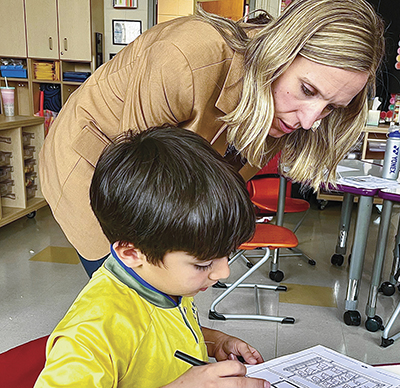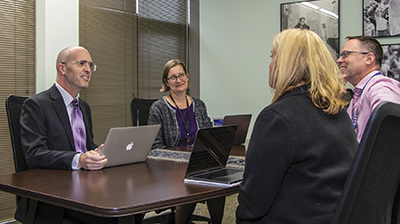This article was written by Kurt A. Schneider, Mary Morgan Ryan, and Kristen Ninni and published by AASA, the School Superintendents Association and appeared in August 2023: School Administrator.
How do you look for effective inclusion of students with disabilities across the school system?

Historically, elementary and secondary education has grouped students based on ability, identified needs, language or student behavior. This led to educational practices that support separateness.
In school systems nationwide, including those located in the suburbs of Chicago where we lead an educational cooperative, we have constructed a normed group of students whom we label “general education students.” Non-general education students usually are those who do not meet the criteria of academic, language, physical, emotional, social or behavioral success of the normed or dominant group.
Of the 36,205 students in 62 schools in our cooperative’s member districts, 13.3 percent have individualized education plans and receive services under the federal Individuals with Disabilities Education Act of 2004.
Getting Started
To know whether your school system is perpetuating practices associated with segregation and marginalization, you must understand your district’s equity data and instructional service delivery across all student groups. For the students with disabilities group, disaggregate that data even further based on the eligibility areas associated with the Individuals with Disabilities Education Act (e.g., autism, cognitive/intellectual or emotional/behavioral disabilities).
In our case, a beginning step was a “profile meeting” with each of the 18 school districts in our suburban cooperative to discuss their local data across student groups. We reviewed that information in conjunction with regional trends and state averages. At annual profile meetings, we focus on reviewing data from each district’s state report card and federal indicator data and discuss member districts’ strategic initiatives and goals for the coming year. This information is integrated into existing plans and builds the partnerships to co-create inclusive environments.
TrueNorth Educational Cooperative 804, in partnership with our member districts, is working to ensure learners of all backgrounds, especially those with disabilities and complex needs, have equitable access to meaningful educational experiences. With that foundation, students can truly live, work and play within their communities.
While equity work in education is challenging, we are proud to share that such work has resulted in a seven-year positive trend across all member districts. Today, 73 percent of students with IEPs in early childhood through age 22 — up from 62 percent in 2016 — spend more than 80 percent of their school day with their nondisabled peers. If the goal of the Every Student Succeeds Act of 2015 is to close academic gaps, then increasing access to learning opportunities with rigorous core instruction must occur for all students.
Delivery Models
When examining equity data, we discuss the instructional models in each content area to better understand if those instructional models adopt a program model or an integrated model, an important distinction.
The features of a program delivery model, as defined by Colleen Capper and Elise Frattura in their book Meeting the Needs of Students of ALL Abilities: How Leaders Go Beyond Inclusion, include:
routinely separating students from their peers during core teaching and learning;
designating students as in need of special services at proportions that exceed natural proportions in classrooms;
fragmenting students’ daily schedules by moving them from location to location to receive services;
isolating teachers who serve students with disabilities through scheduling and physical location, which inhibits the sharing of instructional expertise;
overlooking the individual needs of students with disabilities; and
regularly requiring students with the most complex needs to attend specific school programs segregated from peers for the majority of their day or in other schools altogether.
As a result of this model, learners are labeled by the specific program they attend (such as special education students) or by the intervention they receive (such as Tier 3 students). These programs typically are run outside of the general education environment. Students are tracked and marginalized for large portions of their school day and rarely participate in educational experiences that provide access to the core curriculum.
By contrast, integrated comprehensive service delivery models ensure meaningful access to the core curriculum and educational experiences with peers. In their book, Capper and Frattura report that delivering services in this manner raises the capacity of educators to accommodate student differences in a manner that minimizes student isolation and fragmentation.
An integrated approach not only is supported by educational research across various equity scholars but also is one of the four pillars of opportunity included in ESSA. This overarching law encompasses all learners and is meant to ensure every student has a quality education and that schools are held accountable for their students’ academic achievement.
This idea is further reinforced by IDEA for students with disabilities. Since its inception in 1975, this federal mandate has stated that students with disabilities should be educated alongside their nondisabled peers in their least restrictive environment, in their home districts, schools and classrooms to the greatest extent appropriate.
In the work taking place within our cooperative and among our suburban school districts, the most common integrated service model practices include planning instruction for the full range of learners within every classroom and grade; eliminating classrooms and schools established to exclusively serve labeled students; building upon culturally relevant curriculum based on universal access; sharing expertise across roles and with job-alike colleagues; and proactively supporting students based on identified strengths and needs.
Equity Assessments
For a school district, launching an equity audit may lead to inclusive educational practices. Regularly examining your data for inequities and proportional representation reveals whether a school and district is truly inclusive.
In his 2021 book Stuck Improving: Racial Equity and School Leadership, Decoteau Irby puts forward the idea that schools are built around the typical general education student. The system must be retrofitted for students who learn differently. As a result, these students often are not successful, perpetuating the perception that diverse learners cannot achieve academically.
When examining disaggregated data, student groupings ought to be proportional to their representation in the population, without overrepresentation in a specific education category. For example, to identify achievement and opportunity gaps you must examine school- and district-level state assessment data across all content areas for students by race/ethnicity, English language learning, disability and income status.
Graduation rates, postsecondary enrollment and completion rates and discipline data are equity indicators that reveal systemwide inclusive instructional practices in schools.
TrueNorth worked with member districts to develop and conduct a self-assessment tool and process. This reviews quantitative data from state reporting, an equity audit based on the Integrated Comprehensive Systems for Equity framework, a rapid improvement practices rubric from The Center for School Turnaround and Improvement, as well as qualitative classroom observations and educator interviews.
The mixed method review prompted some school districts to strengthen existing strategic plan goals, not create additional goals and plans. Other districts hired consultants to conduct evaluative audits that found gaps in achievement and access to rigorous core instruction.
Placement Data
The intentionality and spirit of IDEA has been clear for nearly 50 years that students, regardless of their disabilities, should attend school in their home district, in their home school, in a homeroom class with their peers to the greatest extent appropriate. Our implementation largely has fallen short.
School district leaders must analyze educational placement data to understand the least restrictive environment, which sheds light on a district’s inclusivity. Known as Indicator 5 under IDEA, the LRE is broken down into categories based on the time students spend in the general education classroom as follows:
80 percent or more of the day (least restrictive);
40-79 percent of the day;
less than 40 percent of the day; and
separate schools, residential facilities or home-bound/hospital placements (most restrictive).

Tracking least restrictive environment data involves measuring the percentage of students with disabilities in each of the LRE categories. Identifying and monitoring strategic goals around placement will assist learning outcomes.
Examining Beliefs
Finally, looking critically at the attitudes and beliefs of school district staff helps to assess comfort and capacity with respect to equitable practices across different learners.
One such tool, the Maryland Coalition for Inclusive Education’s Inclusive Education Staff Survey, is designed to help school districts identify the support needed to increase the delivery of special education services within general education settings. Supporting inclusive practices requires establishing shared beliefs, identifying and addressing staff concerns, building staff capacity and providing necessary support for implementation.
Believing all educators want to do what is right and good for students and understanding comfort levels and support needs to be successful will lead to the development of inclusive school districts. n
Kurt Schneider is superintendent of TrueNorth Educational Cooperative 804 in Highland Park, Ill. Mary Morgan Ryan is assistant superintendent of technology, communication and data services in TrueNorth. Kristen Ninni is assistant superintendent of learning and innovation in TrueNorth.